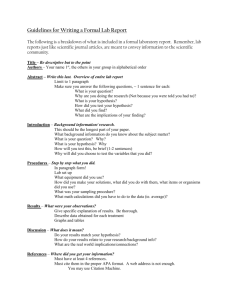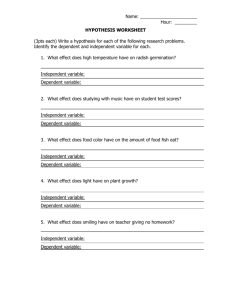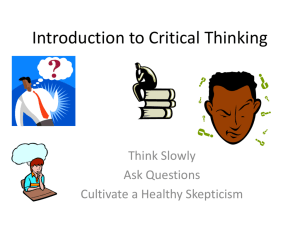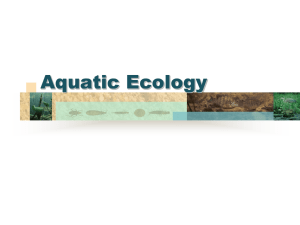EcoColumn Write-up
advertisement
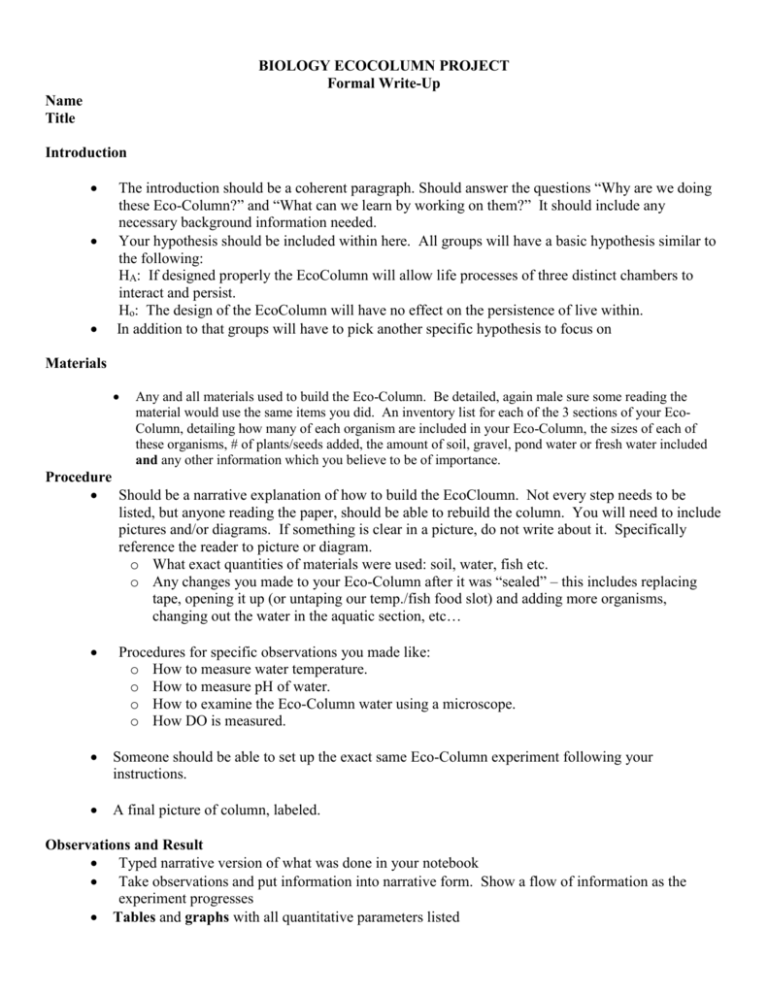
BIOLOGY ECOCOLUMN PROJECT Formal Write-Up Name Title Introduction The introduction should be a coherent paragraph. Should answer the questions “Why are we doing these Eco-Column?” and “What can we learn by working on them?” It should include any necessary background information needed. Your hypothesis should be included within here. All groups will have a basic hypothesis similar to the following: HA: If designed properly the EcoColumn will allow life processes of three distinct chambers to interact and persist. Ho: The design of the EcoColumn will have no effect on the persistence of live within. In addition to that groups will have to pick another specific hypothesis to focus on Materials Any and all materials used to build the Eco-Column. Be detailed, again male sure some reading the material would use the same items you did. An inventory list for each of the 3 sections of your EcoColumn, detailing how many of each organism are included in your Eco-Column, the sizes of each of these organisms, # of plants/seeds added, the amount of soil, gravel, pond water or fresh water included and any other information which you believe to be of importance. Procedure Should be a narrative explanation of how to build the EcoCloumn. Not every step needs to be listed, but anyone reading the paper, should be able to rebuild the column. You will need to include pictures and/or diagrams. If something is clear in a picture, do not write about it. Specifically reference the reader to picture or diagram. o What exact quantities of materials were used: soil, water, fish etc. o Any changes you made to your Eco-Column after it was “sealed” – this includes replacing tape, opening it up (or untaping our temp./fish food slot) and adding more organisms, changing out the water in the aquatic section, etc… Procedures for specific observations you made like: o How to measure water temperature. o How to measure pH of water. o How to examine the Eco-Column water using a microscope. o How DO is measured. Someone should be able to set up the exact same Eco-Column experiment following your instructions. A final picture of column, labeled. Observations and Result Typed narrative version of what was done in your notebook Take observations and put information into narrative form. Show a flow of information as the experiment progresses Tables and graphs with all quantitative parameters listed Conclusion Should be a coherent paragraph(s) which sums up the purpose of the project and all that you have learned. O Should answer the questions “Was my hypothesis answered or disproved through the EcoColumn experiment?”, “What parts of my data and observations support my conclusion?”, “If we were going to do another Eco-Column project, what would we do differently?” and “What questions for further research does this project raise for us?” Follow Up Questions Use these follow up questions to guide your conclusion. You should be able answer most if not all of these question. 1. Identify the roles of factors such as decomposers, producers, and consumers. For example fish are consumers of plants and dead materials. 2. Identify the food chains/web in each of the habitats (terrestrial, aquatic, and decomposition). 3. Identify and briefly discuss the biogeochemical cycles which are taking place/which are present in your Eco-Column. Do not merely state that “they are all present”; instead, provide more specific information. 4. Was your Eco-Column a closed system or an open system or something in-between? How does this affect your Eco-Column? 5. Were there any micro-organisms in any of the chambers of your Eco-Column? If so describe what they looked like. What do you think was causing the micro-organisms? 6. Try and figure out how the three habitats have affected each other. Is your Eco-Column stable? Do some Eco-Columns appear to be more stable? Why is this so? 7. Compare your lab group’s somewhat “contrived” or “manufactured” ecosystems with ecosystems found outside the classroom. Describe (i) three similarities and (ii) three differences.

